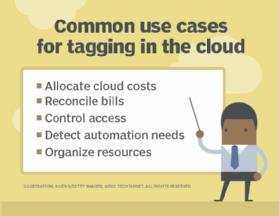
Getty Images/iStockphoto
6 steps to build a comprehensive cloud tagging strategy
A poorly executed cloud resource tagging strategy, or having no strategy at all, can cost a bundle down the road. Build the best tagging strategy with these six steps.
It's hard to manage something if it cannot be identified. In cloud computing, management is greatly assisted when a resource has a meaningful name, or a "tag."
Cloud providers routinely tag resources with unpronounceable -- and unrememberable -- labels, but user-assigned tags, when properly crafted, can organize cloud resources and facilitate everything from changing policies and billing audits to security and availability.
Learn what a tag is, its importance and six key steps to building a cloud tagging strategy.
What is a tag?
A tag is a combination of a key (a category name) and a value (the name of something in that category). An often-cited example is Environment as a key, and Development, Testing and Production as values.
User tags help to more easily identify resources and can also provide multiple identities for potential cross referencing. For example, a resource might be tagged as Environment-Production and Organization-Finance.
Core steps of a cloud tagging strategy
A valuable cloud tagging strategy hinges on two things:
- the ability to create a truly useful tag; and
- the ability to provide consistency in their application and use.
Tagging isn't a one-time task. Rather, it's a commitment to a way of organizing and monitoring cloud resources that should pay dividends in proportion to how seriously you take the work in the long term. Use the following steps to build your strategy.
Step 1. Use a team approach to find tag requirements

A good tagging strategy starts with a team, which should represent all the organizations that have a need or reason to reference cloud resource information. The team's goal is to collect all the uses of data, then decide how those uses could be facilitated through the tags.
Some users recommend that the initial team process should first focus on general requirements, rather than on defining tags, to avoid committing to something before they collect all the essential information. As a guide, three specific areas that will likely benefit from tagging are:
- Finance and settlement
- Operations and monitoring
- Planning and organization
Step 2. Group by data usage
After collecting the data usage, it's time to think about tags. Experience favors a top-down approach, so start by grouping data usage requirements by organization to ensure that you can separate the stakeholder requirements and map all data usage to a tag or set of tags. This is the "who-knows" dimension of tagging, and it may be as simple as creating a set of keys and values to identify the organizations that made team contributions.
Step 3. Set up tags for common tasks
The next step is to look at the "what-knowledge" dimension, which is the usage of the data. Here, it's important not to create specialized usage tags for each organization. Cost allocation and budget reconciliation, common tasks that tags can facilitate, will normally be done the same way everywhere, so set up a common tag set for these tasks.
Step 4. Generalize roles
Tasks, such as access management and applying security/compliance constraints, create the "how-used" dimension. Like the "what-knowledge" dimension to tagging, these activities may cut across organizational boundaries. Often this set of tasks and related data will directly relate to a worker's role. Here, it's important to generalize roles to the greatest possible extent to ensure that you don't end up with thousands of key/value tags.
Start with the assumption that you have a single role -- for which you can use the keyword "Role" -- then assign roles as broadly as possible, consistent with your constraints. If necessary, you can add a "JobLevel" keyword to separate worker/supervisor rights.
Step 5. Determine how to tag
Now you're ready to tag. It's best to assign the responsibility for the actual tagging of resources to the operations group that manages the cloud. The adage "tag everything" applies here. Tag all current resources with every appropriate tag, even if all the tagging combinations aren't currently in use. Tag each new resource immediately before use.
Identify the tags associated with resources, send the results to the original planning team for review, and then apply the tags from the top down. Most companies like to run reports at this stage to see how the tagging strategy organizes resource data, and to aid in refining tags when necessary.
Step 6. Create a tag plan
The final step is to create a tag plan to document your results. This plan must be kept current with any changes in either the tags or the tagging process. It should document all the current tags and the reason for each, the way that resources should be tagged and the organizations responsible for tagging and review, and examples of how each organization uses the tags.
Tag strategies are all about planning, so it's wise to consider these preliminary steps before you begin. A bad tag plan, or no plan at all, could potentially cost a business time and money down the line.







